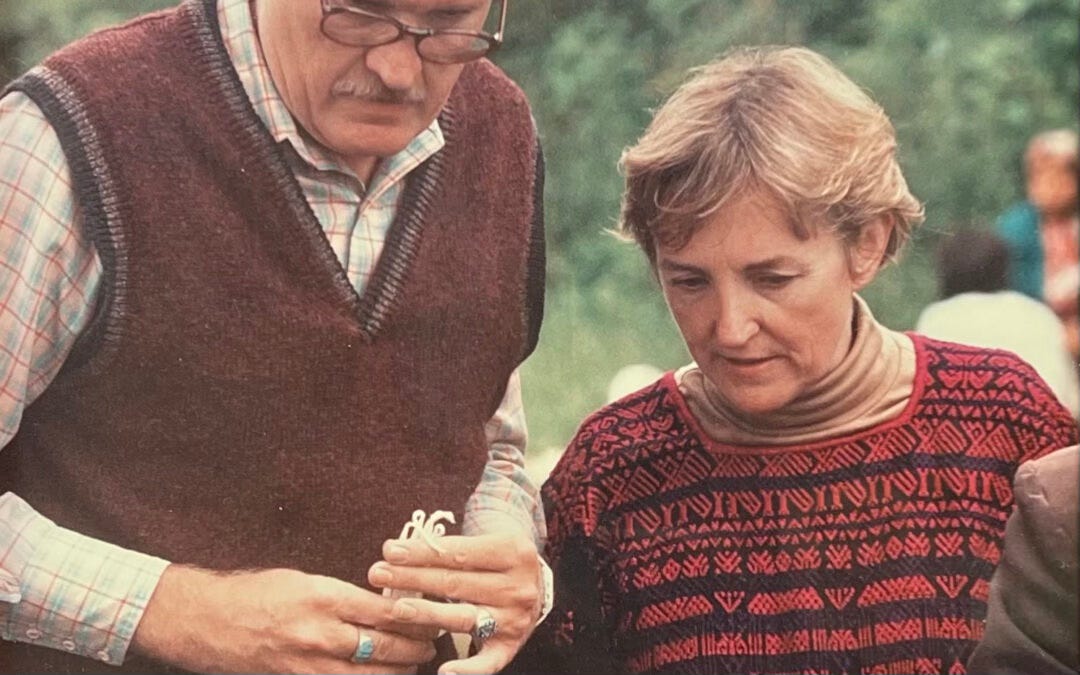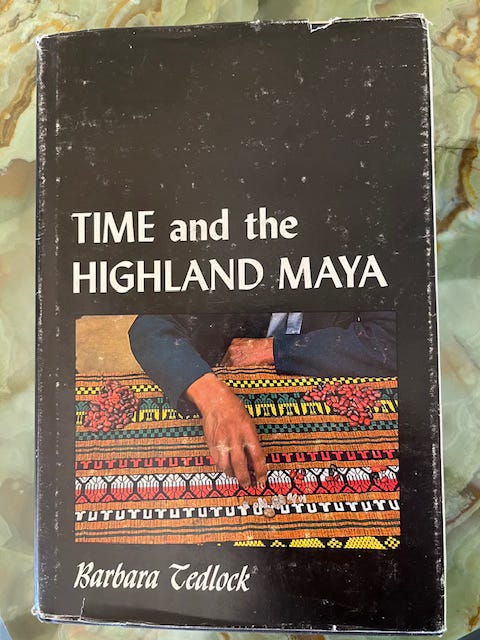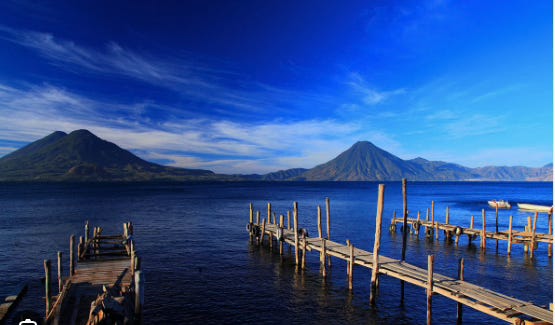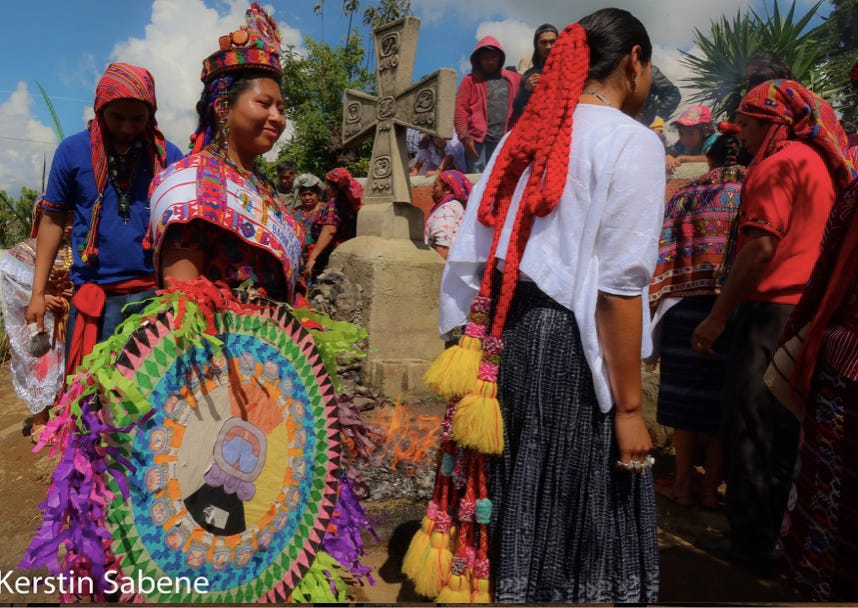Between Two Worlds: The Cultural Anthropologist Who Bridged Modern Science and Maya Timekeeping
Women Trailblazers: Barbara Tedlock—Unlocking Maya calendar wisdom through cultural study
Hola Amigos! Continuing with my Women Trailblazers series, this post introduces you to Barbara Tedlock. Along with her husband Dennis, also an acclaimed scholar, they pursued anthropology the old-fashioned way: boots on the ground. At one point accused by fellow academics of having “gone native,” they continued to follow their bliss.
Equipped with all the right stuff—proper credentials, years of study, indomitable spirit—cultural anthropologist Barbara Tedlock spent a lifetime exploring the spaces between the lines in numerous ethnic cultures.
With a masters degree in Ethno-musicology along with a masters and PhD in Anthropology, she and husband Dennis Tedlock, leading expert of Mayan language, revered for his translation of the Popul Vuh: Mayan Book of the Dawn of Life, traveled the world to engage in a new kind of cross-cultural understanding. Their aim was to learn how cultures think, dream, heal, honor their ancestors, and live.
Though publish or perish is touted as the credo defining a successful career in higher education, including anthropology, for anthropologists, diving into the field is their life blood. Tedlock, also a key figure in anthropological dream research, authored several books, scores of articles, and was interviewed in videos and in print media. This post centers on Time and the Highland Maya, 1exploring how the Maya view time. While it was suggested that the foundation of Maya kings’ power and divinity was their esoteric knowledge of time, Tedlock went out to discover the truth.
Time and the Highland Maya
The Tedlocks' fieldwork initiated in Guatemala in June 1975 and lasted three months. They spent another ten months in country in 1976, and another three months in 1979. They conducted formal, structured ethnographic surveys as well as informal, unstructured interviews. Covering all bases, they read from ethno-historical documents with consultants and viewed previously reported “facts" through observation and eventually through their own apprenticeships.
Studies were conducted in five K'iche' communities (Indigenous Maya), with the majority of time being spent in Momostenango, Guatemala. They left no stone unturned, interviewing weavers, merchants, farmers, town officials and various religious specialists ranging from members of a Catholic Action group to dozens of priest-shamans.
A rare apprenticeship
In wide ranging and divergent strategies in investigating the culture, Barbara discussed a 1722 historical document, a Maya calendar that was written in the K'iche' language, with a Momostenango elder.. Tapes were made during both formal and informal interviews. In the middle stages of Barbara's work in Momostenango, she and Dennis undertook formal training as calendar diviners and were initiated in August, 1976. This allowed them to perform calendrical divinations for K'iche' Maya who solicited their services.
Maya calendar
Quoting Barbara Tedlock, "The ancient Maya were great horologists, or students of time. They measured the lunar cycle and solar year; lunar and solar eclipses; and the risings of Venus and Mars with accuracy. In many cases their measurements were more accurate than those of the Europeans who conquered them.
"Unlike the Europeans," she continued, "Maya were interested not only in the quantities of time but also in its qualities, and its meaning for human affairs."
Though the Tedlocks were quick to understand Maya astronomy practices, efforts to inhabit their symbolic world became demanding and more nuanced.
As explained by Barbara, the very foundation of their calendar—composed of myriad overlays of cycles of differing lengths and portents—rested on a cycle of 260 named and numbered days, the Tzolk’in. The names of this cycle had no obvious correlation with astronomical events and the names of its days and their divinatory interpretations were largely lacking in astronomical references.
Highland vs. Lowland interpretations
According to Barbara Tedlock, among the Lowland Maya of the Yucatán, the ancient ways of interpreting time are known from inscriptions on thousands of stone monuments (stela) and from the few ancient books that survived the fires of Spanish missionaries along with a handful of early colonial documents. But the contemporary indigenous people of the Yucatán and the Lowland regions have long since forgotten how to keep time in the manner of their ancestors, she observed.
But with the Highland Maya, and especially those from the western Guatemala Highlands where the Tedlocks landed, the situation is reversed. Monuments are bare of inscriptions and none of the ancient books escaped the flames. But it is among the Highland Maya not their Lowland cousins, where time continues to be calculated to this day according to ancient methods. Scores of indigenous Guatemalan communities speaking Mayan languages keep the 260-day cycle and, in many cases, the ancient solar cycle as well.
Gods rule the day in Tzolk’in calendar
For this reason, Tedlock chose this particular region in western Guatemala's Highlands to study and work. It is here where she was confirmed as a day keeper. "The Tzolk'in calendar," she said, "was primarily used for making predictions and communicating with the gods or ancestors.
"The Maya believe a god rules each day and depending on that god's traits, it could be good or bad for certain activities. The calendar is easy to remember and that's why it has been passed down and used to this day. It fits into the culture of the people.
"It fits into their agriculture, their spinning, their weaving. It's something people use and it doesn't conflict with our calendar," she explained. "People look at the characteristics, the god, of every day. If it's a day that relates to money, then it's time to pay bills."
Recruitment
Being indoctrinated as a day keeper for a non-indigenous person is almost unthinkable. But the Tedlocks came to it through a combination of chance and circumstance. In the 1970s, in a formal apprenticeship, they were indoctrinated by a diviner in Momostenango. This is no small undertaking. Day keepers are commonly recruited in shamanistic fashion, with "divine election" through birth, dreams, and/or illness.
They'd been spending a lot of time in various Highlands pueblos, walking the area, touring churches, asking questions. A day keeper divined that they were annoying people at shrines. He told them they had entered shrines without being ritually clean.
A little scared by his remarks, they left the Highlands for the city where Barbara became seriously ill. Her illness eventually passed and they returned to Momostenango where they renewed contact with the day keeper. Shortly afterwards he entered them into their apprenticeships.
Divine election
Barbara Tedlock’s, "divine election" had come about through illness. Their unusual opportunity to learn divination was provided to them by a gifted, socially prominent priest-shaman who had noticed their intense interest in the topic and observed Barbara's cooperation in answering questions he asked during the calendrical divinations he performed for her during the illness.
His high status and reputation allowed him to risk potential public and private criticism for accepting foreigners as students. Both Barbara and Dennis were trained and initiated together because it was divined that their joint indiscretions had caused her illness, and also because their teacher had a series of dreams that recommended “united"service for them.
Barbara's role in learning of divinatory service involved a position not formally discussed in the sociological or anthropological literature on the topic of fieldwork, namely, participant-as-observed. Shortly after beginning formal training, Barbara realized that her teacher's personal commitment to their training was extremely serious. If they failed as students, he failed, and their social disgrace would become his.
Village life
With that being said, they settled into village life in Guatemala, became initiated as day keepers, learned the rituals, and made fewer treks north. As time went on, their stateside contemporaries said they had gone native, not unlike the consensus among famed anthropologist Margaret Mead and her husband's fellow anthropologists during their work in Papua New Guinea and the South Seas from 1925 to 1939.
As for their roles as anthropologists, the Tedlocks returned to them in full as soon as the liminal period was over, on the day of their initiation.
How Maya cosmos and calendar applies to daily living
Barbara Tedlock's account of the ritual life of an Indigenous community in Guatemala offered a rare glimpse at the importance of ancient religious symbols in the daily world of a twentieth-century Indigenous people. Her participation in the calendric rituals that permeated every aspect of life in Momostenango gave her a unique perspective on the fascination with time that has long characterized the Maya culture.
The Classic Mayan obsession with time has never been better known. Through Tedlock’s study with the present day keepers of the calendar, she refuted long-held ethnographic assumptions and opened a door to the order of the Mayan cosmos and its daily ritual of how the calendars work.
Tedlock returned to the Highlands in 1989 after Guatemala’s brutal civil war and found observance of the traditional calendar and religion was stronger than ever. No amount of strife or political upheaval could deter the Maya from their relationship with something as old as time itself, their calendar.
Tedlock authored a number of books including The Woman in a Shaman's Body; Dreaming: Anthropological and Psychological Interpretations; The Beautiful and the Dangerous: Encounters with the Zuni Indians. Print, radio and TV interviews were numerous including two BBC series, NBC, The History Channel, PBS, San Francisco Chronicle, LA Times, Scientific American, Christian Science Monitor, and many others.
Her books explored cross-cultural understanding and communication of dreams, ethno-medicines, and aesthetics.
Barbara Tedlock died in October 2023, in New Mexico. Her husband Dennis died in 2016.
Barbara Tedlock. Time and the Highland Maya. University of New Mexico Press. (January 1982).
If you’re interested in supporting well-researched and thoughtful writing and you’ve been enjoying my posts and are feeling generous, your paid subscription would make my day. Keep up to date on Mexico, travel, chapters from Where the Sky is Born—how we bought land and built a house on the Mexico Caribbean coast. And opened a bookstore, too! All for $5/monthly or $50 per year.
Hit the heart at the top of this email to make it easier for others to find this publication (to stimulate those pesky algorithms) and make me very happy.
Backstory—Puerto Morelos sits within 100 miles of four major pyramid sites: Chichen Itza, Coba, Tulum and Ek Balam. By living in close proximity to this Maya wonderland we pyramid hopped on our days off from Alma Libre Libros, the bookstore we founded in 1997. Owning a bookstore made it easy to order every possible book I could find on the Maya and their culture, the pyramids, the archeologists who dug at these sites and the scholars who wrote about them, not to mention meeting archeologists, tour guides, and local Maya who popped into the store. I became a self-taught Mayaphile and eventually website publishers, Mexican newspapers and magazines, even guidebooks asked me to write for them about the Maya and Mexico. I’ll never stop being enthralled by the culture and history and glad there’s always new news emerging for me to report on right here in Mexico Soul. Please share this post if you know others interested in the Maya. Thank you!















It is with pleasure, And anticipation, That I have finally been able to sit down I read my friends Is extremely interesting an informant blog. The reason it's taken me so long, Is that I have been going through many personal issues and situations. I wanted to be able to give my full attention to her Writings, Which I am so envious of, I am not a writer; obviously, Jeannine always inspires me to learn more. Thank you my friend
Did the Mayans never have enough time, like those of us who are not Mayan? Great delve into the Mayan concept of time, Jeanine!